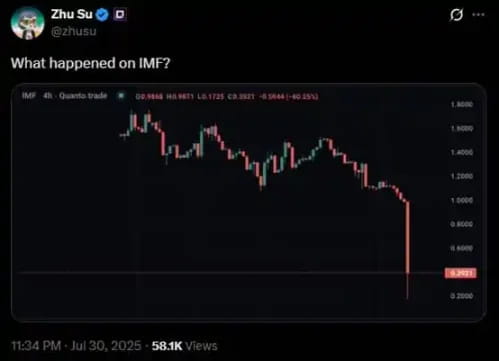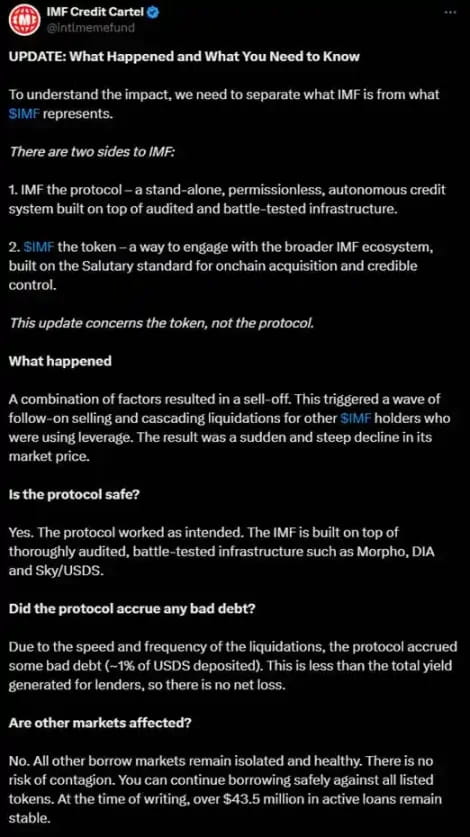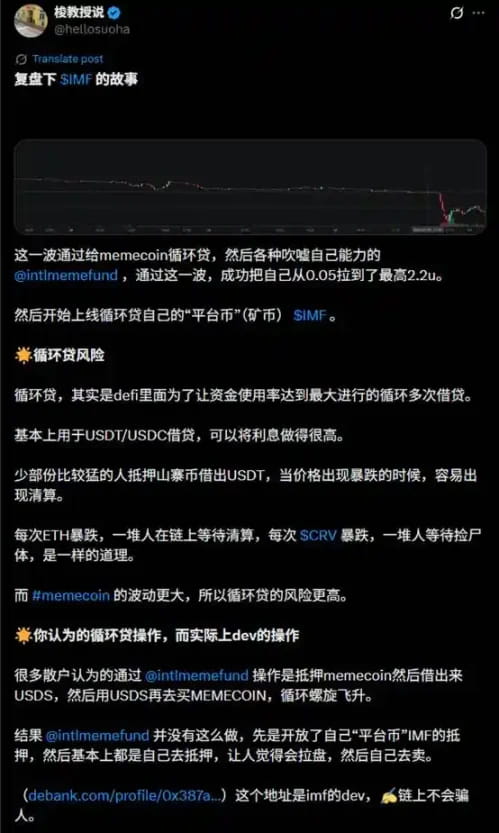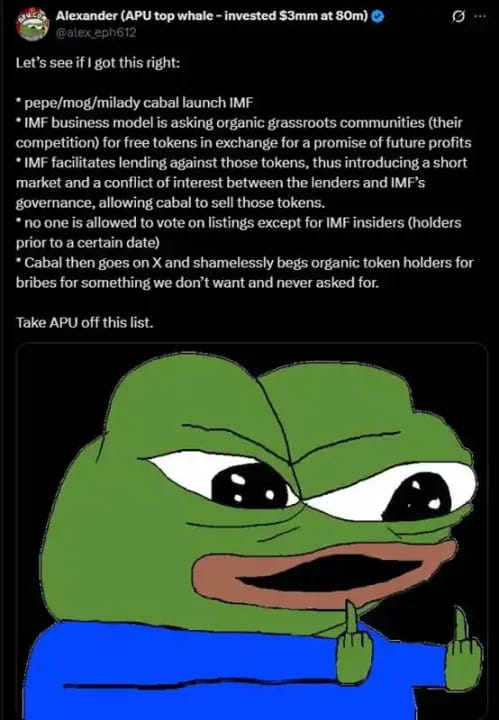Written by: Cookie, Rhythm
From early June to early July this year, $IMF, as a MemeFi project on the Ethereum mainnet, rose nearly 70 times at its peak. Although $IMF gradually corrected by 50% after reaching a historical high market cap of $70 million, a massive drop of nearly 85% yesterday shocked the market.

$IMF's decline shocked Zhu Su.
What exactly happened that caused such a huge drop in $IMF?
What is IMF?
IMF (International Meme Fund) is a decentralized financial platform tailored for meme tokens on the mainnet, allowing users to collateralize meme coins such as $PEPE, $JOE, and $MOG to borrow stablecoin $USDS without selling to realize liquidity. At the same time, through modules like Accelerate and Amplify, project parties or whales can leverage to pull prices, cycle lending to guard against losses, and even create a 'lock-up' illusion while actually achieving early exit and shadow fund management.
Through IMF, the circular lending of meme coins can be realized, achieving a 'left foot stepping on the right foot', for example:
· Buy $10,000 PEPE
· Deposit PEPE into IMF and borrow $5,000 USDS loan
· Exchange USDS for PEPE
· Deposit the remaining $5,000 PEPE to reduce the loan-to-value ratio (LTV)
Currently, the TVL of IMF is still about $166.5 million, with a total of about $54 million of $USDS deposited, about $29.22 million of $PEPE, about $20.58 million of $stETH, about $44.4 million of $MOG, about $5.88 million of $JOE, about $4.94 million of $SPX, and about $7.5 million of $IMF as collateral.
Why did $IMF plummet?
According to a tweet released by IMF, this sudden drop of $IMF was not due to problems with the protocol itself, but because the $IMF token itself faced sell-offs, which triggered more panic selling and subsequent liquidations leading to a significant drop in the price of $IMF.
The official Twitter account also stated that due to the speed and frequency of liquidations, some bad debts have accumulated (about 1% of USDS deposited). This is lower than the total earnings generated by lenders, hence there is no net loss. In addition, the issues occurring in the $IMF lending market do not affect other lending pairs on the platform.

@2025Spider tweeted that his friend sold $IMF worth $100,000 at a price of 1.02U, triggering a series of liquidations. He stated that his friend did not intend to harm the IMF project and suggested that the project team should close the IMF lending positions, otherwise USDS would face significant risks. He also mentioned that the team's oracle update speed is very slow, and when most IMF/USDT positions are unable to repay, the oracle still has not updated to the latest price in time.
Regarding the opening of its own platform token $IMF for collateralized lending, both @2025Spider and Chinese KOL 'Professor Su' have raised doubts.

Someone asked @2025Spider in the comments, 'Is IMF a scam?' @2025Spider replied that the team members are good, but they should not open $IMF for collateralized lending, otherwise there is reason to believe they want to cash out their own tokens like the CRV founder did. He also stated that the loan amount given to $IMF exceeds the liquidity of the $IMF UniSwap pool itself, which should not be the case from a risk control perspective.
'Professor Su' directly questioned the IMF team about their own collateral causing FOMO and then selling tokens for cash out through on-chain records.

The official Twitter account of IMF published a detailed report on this series of liquidation events this afternoon. A total of 260 liquidations occurred, involving 126 independent borrowers, accounting for 15.47% of the total supply of $IMF being liquidated.

Conclusion
After the event, $IMF rebounded nearly 4 times from its lowest point, and currently remains nearly 3 times higher than the lowest point, with a market cap recovering to nearly $21 million.
However, the controversy surrounding $IMF is likely not to end. On July 24, a large holder of the well-known meme coin $APU on Ethereum, @alex_eph612, fired shots at IMF. He claimed that IMF is a conspiracy group initiated by $PEPE, $MOG, and Milady, and that its business model is actually to demand free tokens from other organic meme coin communities in exchange for the short-term buying power brought by IMF, and then the conspiracy group sells the tokens.

IMF quickly retaliated, claiming it did not ask for any bribes, and the standards for listing lending pairs are also public and voted on by $IMF holders.

The 'meme flywheel' of Ethereum will likely face storms.




